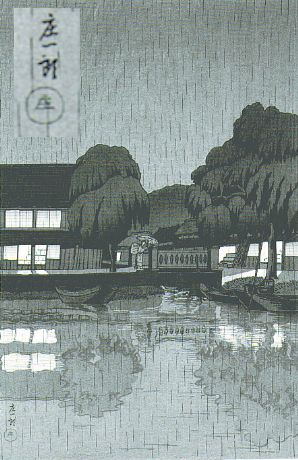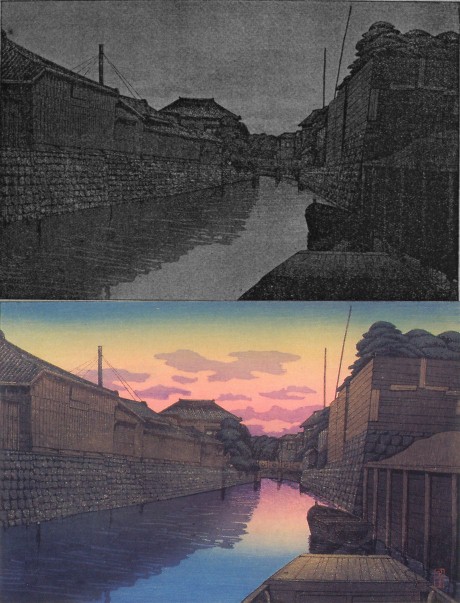Tôkô was a go, or art name, which was used on several prints published by Doi Teiichi.
The identity of the artist (or artists) who actually designed the prints is hidden, but there are some
tantalizing clues pointing to the possibility that Kawase Hasui and/or
Ishiwata Kôitsu may have been involved.
|
||||
|
Catalog:
Here are all of the Tôkô images that I have been able to find. If you have access to
any additional Tôkô prints, please get in touch
so that I can add them to this page.
|
||||
 |
 |
 |
 |
|
Moonlight over Enoshima Beach |
Ferry Landing at Ushibori |
Yoshida Shrine |
Shrine |
|
|
Merritt/Yamada:
Here is a short write-up on Tôkô from my favorite comprehensive reference on all
shin hanga matters, "Guide to Modern Japanese Woodblock Prints; 1900-1975" by Helen Merritt
and Nanako Yamada:
"Prints include Ferry Landing at Ushibori, 1933, published by Doi and
another river scene dated 1950.
The latter has a seal with the kanji "Shô" which suggests the publisher Watanabe Shôzaburô,
but the seal appears to be an integral part of the signature and is unlike any other seal
of Watanabe known to the authors."
If anyone is able to find an image of the 1950 river scene print, I'd love to add it to the
others.
|
||||
|
The Hasui Connection:
Older editions of print T-1, "Moonlight over Enoshima Beach", have the Tôkô signature and seal.
However, more recently produced versions of this same print, with the same keyblock lines,
are signed and sealed by Kawase Hasui.
The current management of Doi Hangaten maintains that this print was designed by Hasui.
However, this design is not included in the Hasui catalog raisonne which was compiled by
Muneshige Narazaki.
Between December, 1931 and June, 1932 Hasui designed 13 prints for Doi Sadaichi.
The Enoshima print is margin dated August, 1933, well after Hasui's time at Doi.
Interestingly, Hasui designed a very similar print for Doi in March, 1932, titled "Spring Moon over
Ninomiya Beach" (pictured below).
The truth of this matter of dual attribution may never be known, but here are
a couple of possible explanations:

| ||||
|
The Case for Ishiwata Kôitsu:
The people at www.artelino.com are convinced that Tôkô
is an art name of Ishiwata Kôitsu. Here's why:
He used different names for different publishers.
Prints designed by him for Katô were signed Shô-ichi-rô.
Prints designed by him for Watanabe were signed Kô-itsu.
Tôkô prints were only published by Doi.
The Kô character from Kôitsu is the same character as the Kô in Tôkô.
The following 2 prints were found by Tosh Doi.
To the right, at the top, is a drawing illustrated at page 325 of "Ukiyo-e Geijutsu Journal"
published in November 1934.
The artist attribution is given to "Ishiwata Tôkô".
Below, is a print with the Watanabe "C" seal and the artist's seal reading "Ishiwata".
This print was sold in a recent JPAA auction.
Having been published by Watanabe, it was attributed to Ishiwata Kôitsu.
The title is "Choshi Minato Bashi", date of publication was January, 1932.
Clearly, this is the same image, attributed to both "Tôkô" and "Kôitsu".
|
||||
|
In Conclusion:
I have become convinced that "Tôkô" is an art name used by Ishiwata Kôitsu.
I believe that the Hasui connection was due to an intentional mis-attribution on the part of
Doi publishers.
I'm interested in hearing from other observers. What are your thoughts on the matter?
|
||||
|
|
||||
| Home | Copyright 2004 by Marc Kahn; All Rights Reserved | |||



 Ishiwata Kôitsu's birth name was Shôichirô, with the first character Shô
being the same character in the seal speculated upon by Merritt and Yamada (above).
The 1936 print depicted to the left titled "Tsuchiura at Dusk in the Rain" was published by Katô Junji,
signed "Shôichirô", sealed "Shô", and attributed to Ishiwata-san.
Ishiwata Kôitsu's birth name was Shôichirô, with the first character Shô
being the same character in the seal speculated upon by Merritt and Yamada (above).
The 1936 print depicted to the left titled "Tsuchiura at Dusk in the Rain" was published by Katô Junji,
signed "Shôichirô", sealed "Shô", and attributed to Ishiwata-san.
